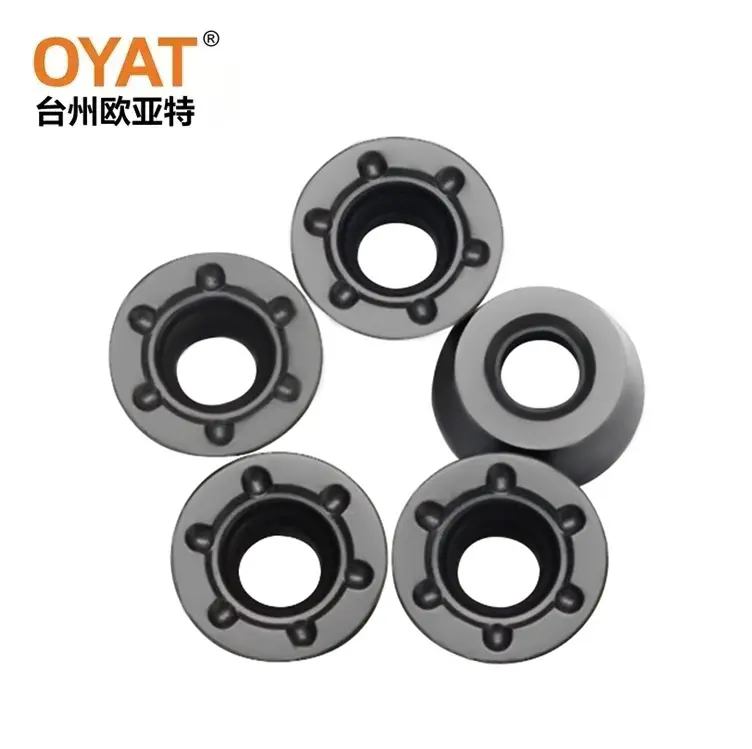What Makes Milling Inserts Indispensable for Modern Machining?
2025-08-07
In the realm of manufacturing, where precision and efficiency dictate success, milling inserts stand as critical components that shape the capabilities of milling machines. These small, replaceable cutting tools are engineered to remove material from workpieces with unparalleled accuracy, enabling the creation of complex shapes, slots, and surfaces across industries ranging from automotive and aerospace to energy and medical device production. As manufacturers strive to meet tighter tolerances, faster production cycles, and diverse material challenges, understanding why high-quality milling inserts are essential has become a cornerstone of operational excellence. This guide explores the vital role of milling inserts in modern machining, highlights their key features, details specifications of our premium offerings, and addresses common questions to help businesses optimize their milling processes.
Trending News Headlines: Top Searches on Milling Inserts
- "How Nanocoated Milling Inserts Extend Tool Life in Steel Applications"
- "Milling Inserts for Hardened Alloys: Latest Materials and Designs"
These headlines underscore the industry’s priorities: adapting to specific materials, leveraging advanced coatings for longevity, and tackling the challenges of machining tough alloys. For manufacturers, staying abreast of these trends ensures they select milling inserts that align with modern production demands.
Why High-Quality Milling Inserts Are Critical in Machining
Superior Precision and Surface Finish
In industries like aerospace and medical manufacturing, where parts must meet exacting standards, even minor imperfections can compromise functionality. High-quality milling inserts are engineered with tight dimensional tolerances and sharp, consistent cutting edges, ensuring precise material removal and smooth surface finishes. For example, a premium insert with a polished cutting edge can achieve surface roughness values (Ra) as low as 0.8 μm, eliminating the need for secondary finishing operations. This precision reduces scrap rates and ensures parts fit together seamlessly, critical for assemblies in high-performance applications.
Enhanced Wear Resistance and Longevity
Milling operations subject inserts to extreme forces, heat, and friction—conditions that quickly degrade low-quality tools. High-quality inserts are crafted from advanced materials (such as micrograin carbide) and fortified with specialized coatings, enabling them to resist wear, oxidation, and thermal shock. For instance, inserts coated with titanium aluminum nitride (TiAlN) can withstand cutting temperatures exceeding 800°C, significantly extending tool life compared to uncoated alternatives. This longevity reduces the frequency of tool changes, minimizing downtime and lowering the total cost of ownership over time.
Increased Productivity and Cost Efficiency
Time is a critical factor in manufacturing, and high-quality milling inserts are designed to maximize throughput. Their robust construction allows for higher cutting speeds, feed rates, and depths of cut without sacrificing precision, reducing cycle times per part. For example, a high-performance insert might enable a feed rate of 500 mm/min in steel machining, compared to 300 mm/min with a standard insert—boosting productivity by over 60% for the same operation. Additionally, fewer tool changes mean machines spend more time cutting and less time idle, optimizing overall equipment effectiveness (OEE) and driving down per-part costs.
Versatility Across Materials and Operations
Modern manufacturing requires machining a diverse range of materials, from soft plastics and aluminum to hardened steels, titanium, and composites. High-quality milling inserts are engineered with specialized geometries and material compositions to handle these variations. For example, an insert with a sharp, positive rake angle excels at machining aluminum, reducing built-up edge (BUE) and ensuring clean cuts, while a rugged, negative rake angle insert with a tough carbide substrate is ideal for roughing operations on cast iron. This versatility eliminates the need for multiple tool types, simplifying inventory management and reducing setup times.
Reduced Environmental Impact
Sustainability is increasingly a priority in manufacturing, and high-quality milling inserts contribute to eco-friendly operations. Their extended tool life reduces waste from discarded inserts, while efficient cutting parameters minimize energy consumption. Additionally, many premium inserts use environmentally friendly coatings (free from harmful substances like hexavalent chromium) and are manufactured using processes that reduce emissions. For businesses aiming to meet green manufacturing standards, these inserts offer a practical way to reduce their environmental footprint without compromising performance.
Key Features of Premium Milling Inserts
Selecting the right milling insert requires understanding the features that drive performance and reliability. Here are the critical attributes to consider:
Substrate Materials
The base material of a milling insert determines its hardness, toughness, and heat resistance:
- Cemented Carbide: The most widely used substrate, composed of tungsten carbide (WC) particles bonded with cobalt (Co). Micrograin carbide (grain size <1 μm) offers superior hardness for precision work, while coarse-grain carbide provides enhanced toughness for roughing operations.
- Cermets: Combinations of ceramic and metal (e.g., titanium carbide with nickel binders) that offer high wear resistance and chemical stability, ideal for finishing operations on steels.
- Ceramics: Aluminum oxide (Al₂O₃) or silicon nitride (Si₃N₄) inserts, designed for high-speed machining of cast irons and superalloys at temperatures exceeding 1000°C.
- Cubic Boron Nitride (CBN): Exceptionally hard (second only to diamond), used for machining hardened steels (HRC 50+) and chilled cast irons.
Coatings enhance insert performance by reducing friction, dissipating heat, and preventing wear:
- Titanium Nitride (TiN): A gold-colored coating that improves lubricity and resists adhesion, suitable for low to medium cutting speeds in steels and non-ferrous materials.
- Titanium Carbonitride (TiCN): Harder than TiN with better oxidation resistance, ideal for high-speed machining of steels and cast irons.
- Titanium Aluminum Nitride (TiAlN): A heat-resistant coating that maintains hardness at high temperatures, perfect for dry machining or high-speed applications in steels and alloys.
- Aluminum Chromium Nitride (AlCrN): Offers superior oxidation resistance up to 1100°C, making it ideal for machining superalloys and titanium.
The shape and design of the insert’s cutting edge influence chip formation, cutting forces, and surface finish:
- Rake Angle: Positive angles reduce cutting forces (ideal for soft materials), while negative angles increase edge strength (better for hard or abrasive materials).
- Clearance Angle: Prevents the insert from rubbing against the workpiece, reducing friction and wear.
- Corner Radius: Larger radii distribute cutting forces evenly, improving tool life, while smaller radii enable tighter corner cuts.
- Chip Breakers: Grooves or recesses that control chip flow, preventing chip entanglement and improving safety, especially in high-speed operations.
Milling inserts come in various shapes to accommodate different milling operations:
- Square (SEHT, SEKN): Versatile for face milling, shoulder milling, and slotting.
- Round (RPMW, RCKT): Provide large cutting edges and even wear distribution, ideal for heavy roughing.
- Triangular (TPMT, TNMG): Suitable for light to medium milling and contouring.
- Diamond (DNMG, DCMT): Used for precision finishing and tight spaces.
Our Premium Milling Inserts Specifications
|
Feature
|
General Purpose Milling Inserts (GP Series)
|
High-Speed Finishing Inserts (HS Series)
|
Heavy-Duty Roughing Inserts (HD Series)
|
|
Substrate Material
|
Micrograin carbide (0.8μm grain size) with 8% Co binder
|
Cermet (TiCN + Ni binder)
|
Coarse-grain carbide (2.5μm grain size) with 10% Co binder
|
|
Coating
|
TiAlN (3-5μm thickness)
|
AlCrN (2-3μm thickness)
|
TiCN + Al₂O₃ (5-7μm thickness)
|
|
Insert Shape
|
Square (SEHT), Round (RPMW), Triangular (TPMT)
|
Diamond (DNMG), Square (SEKN)
|
Round (RCKT), Square (SEHT)
|
|
Corner Radius
|
0.4mm, 0.8mm, 1.2mm, 2.0mm
|
0.2mm, 0.4mm, 0.8mm
|
1.6mm, 2.4mm, 3.2mm
|
|
Rake Angle
|
Positive (7°)
|
Positive (10°)
|
Negative (-5°)
|
|
Clearance Angle
|
7°
|
5°
|
9°
|
|
Recommended Cutting Speed
|
150-400 SFM (steel), 200-600 SFM (aluminum)
|
300-800 SFM (steel), 400-1000 SFM (aluminum)
|
80-250 SFM (cast iron), 100-300 SFM (hardened steel)
|
|
Maximum Workpiece Hardness
|
40 HRC
|
35 HRC
|
50 HRC
|
|
Tool Life (Average)
|
45-90 minutes (depending on material)
|
30-60 minutes (high-speed finishing)
|
60-120 minutes (roughing operations)
|
|
Applications
|
General milling of steels, aluminum, cast iron, plastics
|
Precision finishing, contouring, and high-speed machining
|
Heavy roughing, deep slotting, and machining abrasive materials
|
|
Compatibility
|
Fits standard ISO tool holders
|
Fits high-precision tool holders for finishing
|
Fits heavy-duty tool holders for roughing
|
|
Size Range
|
10mm, 12mm, 16mm, 20mm insert sizes
|
8mm, 10mm, 12mm, 16mm insert sizes
|
16mm, 20mm, 25mm, 32mm insert sizes
|
|
Price Range
|
\(10.50 - \)22.99 per insert
|
\(15.99 - \)30.50 per insert
|
\(18.75 - \)35.99 per insert
|
All our milling inserts undergo rigorous quality control, including dimensional inspections, coating adhesion tests, and cutting performance trials. We use advanced manufacturing techniques, such as powder metallurgy and precision grinding, to ensure each insert meets strict tolerances and delivers consistent results.
FAQ: Common Questions About Milling Inserts



